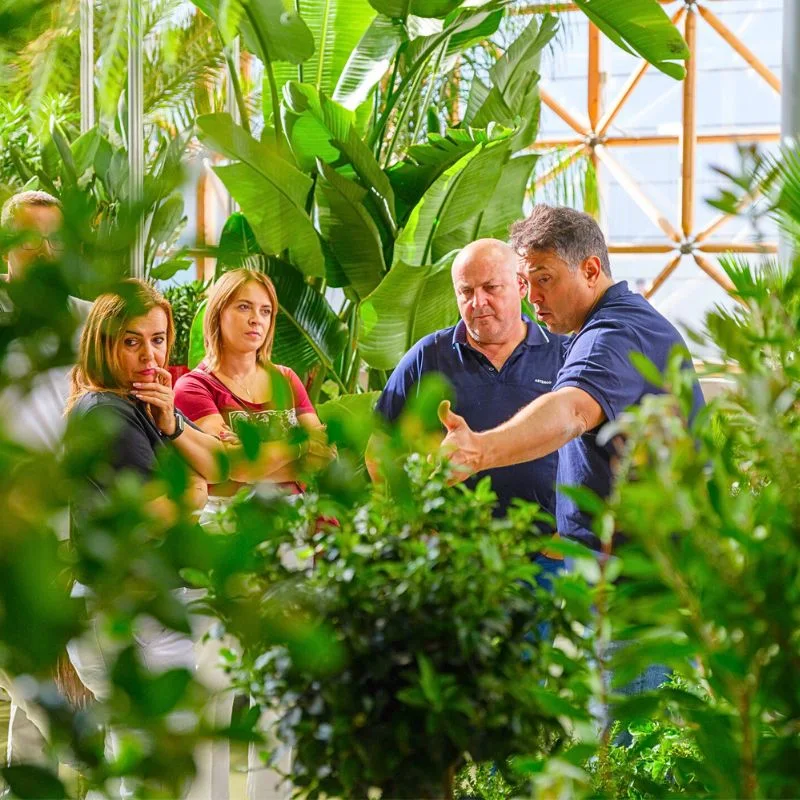The queen palm Tree, scientifically known as Syagrus romanzoffiana, is a popular choice in landscaping due to its graceful appearance and low-maintenance nature. The Syagrus romanzoffiana adds a touch of the exotic to gardens and public spaces, making it a favored ornamental plant.
Being a single-trunked palm tree, its bright feather-like fronds droop softly in a canopy manner, making it a desirable addition to any landscape.
Meaning and Origin of the Queen Palm Tree
The queen palm Tree, sometimes also referred to as palm Syagrus romanzoffiana, is native to South America, particularly Brazil, Argentina, and Paraguay. The genus name "Syagrus" is derived from an ancient Greek word meaning "acorn", while the species name "romanzoffiana" honors Count Nikolai Rumyantsev, a Russian nobleman and patron of exploration.

The palm tree has long been a symbol of victory, peace, and fertility. In many cultures, palm fronds were used in celebrations and religious ceremonies, symbolizing triumph and eternal life. The queen palm, like most palm species, with its feathery, arching fronds, creamy flowers, and tall, slender trunk, embodies these attributes, making it a cherished addition to many landscapes.

Introduced into the landscape world or outdoor space in the late 19th century, the queen palms have over the years become such a delight to landscapers globally. Queen palm, often referred to as cocos palm in some regions, performs well under the USDA hardiness of 9-11 with a growth rate that can reach a staggering height of up to 50 ft (15 m) making it ideal for subtropics or tropical landscapes.
How to Grow Queen Palm
Learn how to grow your queen's palm effectively. This is the most crucial step to having a healthy and thriving queen palm tree on your landscape.
Planting Location of the Queen Palm Tree
Choosing the right location is crucial for the successful growth of this palm tree. The queen palms thrive in full sun but can tolerate partial shade. They prefer well-drained, alkaline soils to neutral pH. Avoid planting in areas prone to stagnating water, as excessive moisture can lead to root rot.
Planting Process of the Queen Palm Tree
To plant a queen palm, follow these steps:
It is crucial to ensure there is enough surrounding space before digging the hole to plant your queen palm tree. Take note that the queen palm tree canopies can spread to 25 ft (8 m). Any obstruction around it will hinder its optimal growth.
- Dig a hole twice the width of the root ball and just as deep.
- Place the palm in the hole, ensuring that the top of the root ball is level with the surrounding soil.
- Backfill the hole with soil, gently tamping it down to eliminate air pockets.
- Water thoroughly to settle the soil around the roots, facilitating proper seed germination.
Newly planted Queen palms benefit from a mulch layer around the base, which helps retain moisture and regulate soil temperature.

Caring for Queen Palm Tree
From watering, pruning to fertilizing, the following caring tips will enhance the growth and health of your queen palm tree.
Watering this Queen Palm Tree
Proper watering is essential for the health of a Queen palm. During the first six months after planting, water the palm regularly, at least once a week. Mature palms are more drought-tolerant but still benefit from regular watering, especially during dry spells and summer months. Ensure the soil remains moist but not waterlogged.

Excessive watering can easily cause root rot, so be mindful of your watering schedule to avoid causing any harm to your palm tree.
Fertilization of the Queen Palm
Queen palms are heavy feeders and require regular fertilization. Use a palm-specific slow-release fertilizer containing essential nutrients such as nitrogen, potassium, magnesium, and manganese. Fertilize every three months during the growing season (spring through fall) to promote robust growth and prevent nutrient deficiencies like manganese deficiency, which is common among this species.

During the feeding process, ensure to water your queen palm, to enhance the uptake of fertilizers and nutrients therein.
Pruning Queen Palms
Pruning is an important aspect of palm tree maintenance. Remove damaged or dead fronds to maintain a tidy appearance and prevent potential pest infestations. Avoid over-pruning, as removing too many green fronds can weaken the tree and reduce its ability to photosynthesize. Focus on dry fronds only, as the lush green ones are the essence of the queen palm and its beauty.
Common Problems Associated with Queen Palms
Caring for your queen palm trees will not be effective if you are not cognizant of common pests and diseases associated with the queen palms.
Nutrient Deficiencies
Queen palms are susceptible to nutrient deficiencies, particularly of potassium, magnesium, and manganese. Symptoms include yellowing fronds, brown leaf tips, and overall poor growth. Regular fertilization with a balanced palm syagrus fertilizer can help prevent these issues.
Pests and Diseases
Several pests and diseases can affect queen palms, including:
- Ganoderma Butt Rot: A fungal disease causing rotting at the base of the trunk. There is no cure, and infected palm trees must be removed, unfortunately.

- Lethal Yellowing: A bacterial disease leading to yellowing and dropping of fronds. Infected palms usually die, and removal is necessary to prevent spread. Removal of yellowing or dry fronds enhances the aesthetic appeal of the queen palm trees.
- Fusarium Wilt: Another severe disease affecting palms, causing wilting and potential death. Preventative care is essential.
- Spider Mites: Tiny pests that cause speckling and webbing on fronds are common with this pam species. Use insecticidal soap or neem oil to get rid of and control the infestations.
Environmental Stress on Queen Palm Trees
Queen palm trees can suffer from environmental stress due to improper watering, extreme temperatures, and poor soil conditions. Ensure your palm receives adequate water, is protected from extreme cold, and is planted in suitable soil. Mulching can help protect the roots and retain soil moisture.

Consistent pruning such as removal of dead fronds, and being on the lookout for pests and diseases can improve the health of your palm tree. If the temperatures become extremely high, a slight increase in the watering schedule will aid in ensuring the optimal growth of your queen palm species.
Queen Palm Fruits, All You Need to Know
The queen palm is a fruit-producing palm tree, producing orange to yellow fruits when ripe. The queen palm fruits are edible and safe for consumption by humans, though not common. The pulp is sweet but fibrous and its taste sometimes not appealing.

It's a great source of food for wildlife, such as birds and mammals, aiding in seed dispersal. However, for pets, specifically dogs and cats, although the fruits are not harmful, consuming large amounts can cause digestive issues due to the fibrous nature of the fruit.

Issues like diarrhea or vomiting can occur. While the fruits are not toxic, it is advisable to prevent your pets from consuming large amounts or from consuming the fruits altogether. Interestingly, cocos australis, another palm species, also produces fruits that are enjoyed by wildlife.

The queen palm plant is a stunning addition to any garden, offering tropical elegance. Understanding its origin, significance, and care requirements will help you cultivate a healthy and beautiful palm tree.
By following proper planting, watering, fertilization, and pruning practices, and promptly addressing common problems, you can enjoy the grace of the queen palm in your garden for many years to come.

Please note that Syagrus romanzoffiana is not overly problematic, but failure to spot issues early can compromise the quality of your palm. Staying on top of problems as they arise allows you to mitigate any risks and consistently take good care of your palm. Enjoy the creamy flowers in the spring, which add to the beauty and elegance of your queen palm tree.
Header image by @Caladium Queen featured image by @Weather Mill










